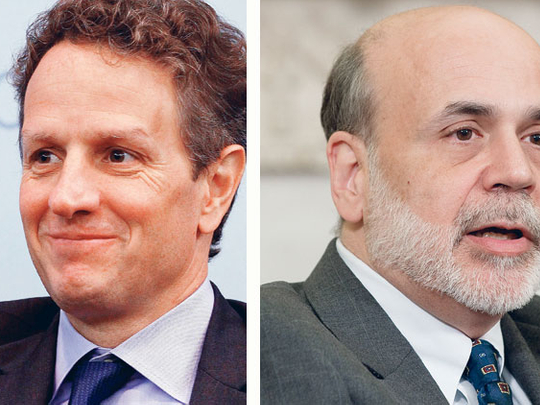
New York : Federal Reserve Chairman Ben S. Bernanke and then-New York Federal President Timothy Geithner told senators on April 3, 2008, that the tens of billions of dollars in "assets" the government agreed to purchase in the rescue of Bear Stearns were "investment-grade." They didn't share everything the Fed knew about the money however.
The so-called assets included collateralised debt obligations (CDOs) and mortgage-backed bonds with names like HG-Coll Ltd. 2007-1A that were so distressed, more than $40 million (Dh146.88 million) already had been reduced to less than investment-grade by the time the central bankers testified. The government also became the owner of $16 billion of credit-default swaps (CDS), and taxpayers wound up guaranteeing high-yield, high-risk junk bonds.
By using its balance sheet to protect an investment bank against failure, the Fed took on the highest credit risk ever in its 96- year history and increased the chance that Americans would be on the hook for billions of dollars as the central bank began insuring Wall Street firms against collapse. The Fed's secrecy spurred legislation that will require government audits of the Fed bailouts and force the central bank to reveal recipients of emergency credit.
Distressed assets
"Either the Fed did not understand the distressed state of some of the assets that it was purchasing from banks and is only now discovering their true value, or it understood that it was buying weak assets and attempted to obscure that fact," Senator Sherrod Brown, an Ohio Democrat and member of the Senate Banking Committee, said in an email when informed about the credit quality of holdings in the Maiden Lane LLC portfolio. The committee held the hearing on April 3.
Maiden Lane, named for a street bordering the New York Fed's Manhattan headquarters, was created to hold the assets the central bank acquired to facilitate JPMorgan Chase & Co.'s purchase of Bear Stearns.
The Fed disclosed the Maiden Lane holdings in March after Bloomberg News went to court using the Freedom of Information Act, and the US District Court in New York held that the Fed should release documents related to Bloomberg's request.
"The Federal Reserve was not straightforward with the American people regarding the risks they were taking with taxpayer money, despite my efforts to obtain such clarity at the time," US Senator Richard Shelby of Alabama, the Senate Banking Committee's top Republican, said. "It is apparent that the Fed withheld from the Congress and the public material information about the condition of these securities."
When Bernanke and Geithner testified in April 2008, $42 million of the CDO securities, the Fed would eventually buy had been downgraded to junk, data compiled by Bloomberg show. By the time the central bank funded its $28.8 billion (Dh105.76 billion) loan to Maiden Lane 12 weeks later, about $172 million of such securities the Fed purchased, were rated below investment grade, according to data compiled for Bloomberg by Red Pine Advisors, a New York firm specialising in the valuation of complex, illiquid securities.
CDOs bundle assets, ranging from mortgage bonds to high-yield loans, and divide them into new slices, or tranches, of varying risks. High-yield, or junk, bonds are those rated below Baa3 by Moody's Investors Service and lower than BBB- by Standard & Poor's."
"As was noted in testimony, all of the cash securities in the Maiden Lane portfolio were investment grade on March 14, 2008, when the deal was agreed to in order to facilitate the acquisition of Bear Stearns and to prevent the systemic consequences of its sudden and disorderly failure," Michelle Smith, a spokeswoman for the Fed's Board of Governors, said.
The Fed valued the loan at $27 billion as of the end of last year, $1.8 billion below the amount that was funded in 2008, according to financial statements audited by Deloitte & Touche LLP.












